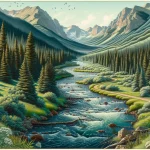The Colorado Gold Rush of 1858 sparked a frenzy that drew thousands to the region, shaping the state’s future and leaving an indelible mark on its history and culture.
In This Article
TL;DR
- The transition from simple gold panning to advanced mining techniques like smelting and cyanide milling.
- Historic towns and ghost towns reflect the boom-and-bust cycle of the era.
- Cultural events and reenactments preserve the mining history and legacy.
The Lure of Gold
In 1858, the discovery of gold in the South Platte River of the Colorado territory ignited a rush that transformed the region. Prospectors flocked to the area, establishing settlements and mining camps to pursue their fortunes. This influx of people and industry laid the foundations for Colorado’s urbanization and industrialization.
When gold was discovered in the San Juan Mountain area, a treaty was negotiated with the Native American Ute people to open the region for settlement.
The Colorado Gold Rush created wealthy men who later played significant roles in Colorado’s history, such as Horace Tabor, the first mayor of Leadville.
The towns of Cripple Creek, Victor, Idaho Springs, Georgetown, Breckenridge, Leadville, St. Elmo, Ouray, Silverton, Durango, Creede, and Telluride flourished during the Gold Rush days. Pikes Peak was the highest-elevation gold mine and led to the development of Fountain Colony and Denver City, now known as Colorado Springs and Denver. Some of these are thriving municipalities today, while others have become ghost town communities visitors can explore.
Mining Evolution
The Colorado Gold Rush witnessed a remarkable evolution in mining techniques. Initially, prospectors relied on simple panning methods to extract gold from streams and rivers. However, as the easily accessible deposits in the Colorado mineral belt dwindled, more advanced techniques like smelting and cyanide milling became necessary to extract gold from hard rock. These industrial processes played a pivotal role in the state’s development.
Historic Remnants
Today, visitors can immerse themselves in the era’s history through preserved mining towns like Central City and Black Hawk. These living museums offer a glimpse into the daily lives of miners and settlers and showcase the challenges and resilience of the communities formed during the gold rush.
Tours of mines like the Mollie Kathleen Gold Mine and the Hidee Gold Mine give you a sense of what it must have been like during the heyday of the Gold Rush.
If you visit the Denver Museum of Nature and Science, you’ll see “Tom’s Baby,” an 11-pound gold nugget discovered near Breckenridge in 1887. It’s officially the largest gold nugget ever found in Colorado.
Cultural Celebrations
The Wild West spirit of the Gold Rush era lives on through various cultural events and festivals. Reenactments and heritage tours bring the era to life, highlighting miners’ and settlers’ daily routines and struggles. Celebrations like the Central City Opera House Festival, Leadville Boom Days, and Gold Rush Day festivals in different towns unite communities and visitors in honoring the mining heritage.
Ghost Towns and Abandoned Mines
Ghost towns and abandoned mines are scattered across Colorado, haunting reminders of the era’s volatility. These eerie sites tell stories of boom and bust, offering a sobering look at the challenges those chasing fortune face.
Outdoor Adventures
The adventurous spirit that fueled the gold rush endures through outdoor activities in the Rocky Mountains. Prospecting tours, fishing in Clear Creek, and exploring the rugged terrain echo the pursuits of the original gold seekers, inviting visitors to experience the thrill of discovery.
FAQ
What are some of the most popular ghost towns in Colorado?
St. Elmo, Animas Forks, and Tomboy are among the most intriguing ghost towns, offering a haunting look at the gold rush’s boom-and-bust cycles.
How can I experience the mining techniques used during the Colorado Gold Rush?
Historical attractions and museums often feature interactive exhibits and demonstrations of placer gold mining techniques, with some providing hands-on experiences.
Are there any guided tours focused on the Colorado Gold Rush Era?
Yes, there are guided tours that explore the history and legacy of the era, including visits to historic mining towns and ghost towns and opportunities to learn about mining techniques.
What are some popular festivals celebrating the Colorado Gold Rush Era?
The Central City Opera House Festival, Leadville Boom Days, and Victor Miners’ Reunion are popular festivals featuring reenactments and cultural activities that celebrate the era’s heritage.
Is there still gold mining in Colorado today?
Yes, there’s still an active gold mine operating in the Cripple Creek mining district: Cripple Creek & Victor Gold Mine.
What’s a troy ounce?
A troy ounce is a unit of measurement used to weigh precious metals, such as gold, platinum, palladium, and silver. It is based on a pound of 12 ounces, rather than the traditional 16, and is equal to 31.1034768 grams, or 0.0311034768 kilograms.
The Colorado Gold Rush Era left an indelible mark on the state’s history and culture, shaping its development and leaving a rich legacy that continues to captivate visitors today. From preserved mining towns to cultural celebrations and outdoor adventures, this era offers a unique window into Colorado’s past and a chance to experience the thrill of discovery that once drew thousands to the region.






